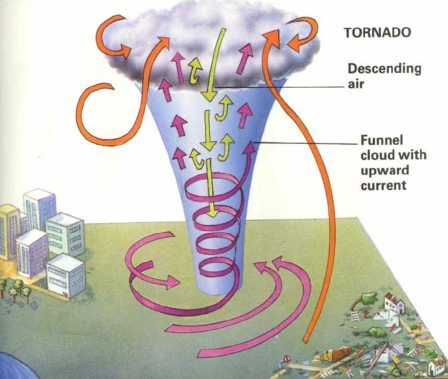7.3.2. Why Thunders are Cause of Concern

Each year, many people are killed or seriously injured by severe thunderstorms despite the advance warning. While severe thunderstorms are most common in the spring and summer, they can occur at just about any time of the year. Cloud-to-ground lightning, Hail, Tornadoes and waterspouts, Flash flood and Downburst are some of the hazards associated with thunderstorm.
There is no safe place outside during a thunderstorm but building constructed according to current guidance could provide safe seltor and avoid injury or death.
Tornado – From severe thunderstorms sometimes spiraling wind descends like a trunk of an elephant with great force, with very low pressure at the centre causing massive destruction on its way. Such a phenomenon is called a tornado. Excessive instability and steep lapse rate in the atmosphere are necessary pre-requisite for the development of a tornado. Tornadoes generally occur in middle latitudes. The tornado over the sea is called water sprouts. Chief features of tornadoes are:
♤ Tornado’s funnel can have size of 90-460m in diameter.
♤ Tornadoes generally occur in middle latitudes.
♤ Tornadoes are the most violent of all the storms.
♤ They are very small in size and of short duration which makes weather prediction difficult.
♤ The velocity of winds revolving tightly around the core reaches more than 300 km per hour.
♤ It causes massive destruction on its way.
♤ When looked at from the ground, the funnel appears dark because of the presence of condensed moisture and the dust and debris picked up from the ground by the whirling tornado.
♤ Tornadoes may be found to be moving singly or in families of several individual tornadoes.
♤ These generally move in straight paths.
These violent storms are the manifestation of the atmosphere’s adjustments to varying energy distribution. The potential and heat energies are converted into kinetic energy in these storms and the restless atmosphere again returns to its stable state.

References:

1. Since sunspots are darker than the surrounding photosphere it might be expected that more sunspots would lead to less solar radiation and a decreased solar constant. However, the surrounding margins of sunspots are brighter than the average, and so are hotter; overall, more sunspots increase the Sun's solar constant or brightness.
2. Electromagnetic radiation is a term used to describe all the different kinds of energies released into space by stars such as the Sun.
3. A photon is an elementary particle, the quantum of light and all other forms of electromagnetic radiation
4. Conductor of heat - Ability to transfer heat to adjacent molecules.
5. The latent heat of condensation for water is defined as the heat released when one mole of the substance condenses to form liquid droplets from water vapour. The temperature does not change during this process, so heat released goes directly into changing the state of the substance. The heat of condensation of water is equal to 40.8 kJ/mol. The heat of condensation is numerically exactly equal to the heat vaporization, but has the opposite sign.
6. Albedo: it is reflectivity or reflecting power of a surface. It is defined as the ratio of reflected radiation from the surface to incident radiation upon it. Albedos of typical materials in visible light range from up to 0.9 for fresh snow to about 0.04 for charcoal, one of the darkest substances.
7. The polar front is the boundary between the polar cell and the Ferrel cell in each hemisphere. At this boundary a sharp gradient in temperature occurs between these two air masses, each at very different temperatures.
8. An adiabatic process is a process that occurs without the transfer of heat or matter between a system and its surroundings.
UPSC Previous Years’ Mains Questions
1. The recent cyclone on east coast of India was called 'Phailin'. How are the tropical cyclones named across the world? Elaborate. (100 words)(UPSC 2013/5 marks)
2. What do you understand by the phenomenon of 'temperature inversion' in meteorology? How does it affect weather and the habitants of the place? (100 words) (UPSC 2013/5 marks)
3. List the significant local storms of the hot-weather season in the country and bring out their socio-economic impact. (UPSC 2010/12 Marks)

4. Write about Nor’westers in 20 words. (UPSC 2008/15 Marks)
.
